When carelessness is completely inappropriate: the procedure for installing a floor-standing gas boiler
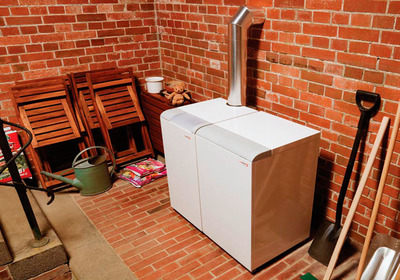
Gas heating has a wide range of advantages, so most homeowners dreaming of an autonomous heating system choose this fuel.
But such a heating system has significant drawback – although, you can install a gas boiler yourself, The devices must be installed by specialists.
Documentation
To install gas heating in a home, you need draw up a number of documents.
Important! First of all, please contact to the gas service, to find out whether installation of such equipment is possible in your conditions. Write a corresponding application. Review periods vary from 1 to 14 weeks.
The result of the application review will be either refusal with reasons, or permission for installation. Together with the permit, you will receive technical specifications. Upon receipt of the permit, order an installation project.

The project will feature gas pipeline layout diagrams inside the building, as well as equipment connection diagrams.
They deal with all the above-described issues gas services assigned to the area where you live. The gas service or other control service also checks the technical documentation of the equipment.
Attention! Before submitting documents for project development, take a look at the boiler and other devices, Check out their specifications but don't buy.
Features of installation of a floor-standing gas boiler
Floor-standing units fit on a specially equipped base so that the gap between the unit and the walls of the room is sufficient for maintenance and repair.
Important! The chimney pipe must be positioned as far as possible further from the window.
Floor standing gas boiler is mounted in a separate room with a large window. The walls of the room are finished with non-combustible materials. Presence in the room false floors or ceilings are not acceptableThe volume of the room depends on the boiler power.

Photo 1. Viessmann Vitogas 100-F floor-standing gas boiler installed in a separate room with non-combustible walls.
The floor-standing boiler is installed so that it can be easy to disconnect and dismantleFor this purpose, the feed and return circuits are equipped with special shut-off valves. After they are closed, the device is freely disconnected from the heating system. The coolant remains in the system.
Work order
Installation of a gas boiler is carried out in the following order:
- clear a section of the wall, next to which the equipment will be located. Between the layer of fireproof material and the wall itself there should be the gap is not less than 4.5 cm;
- prepare the equipment for installation. Using high pressure water, clean all inlet pipes from small debris;
- install on the tube for supplying coolant filter and shut-off devices;
- install a chimney in accordance with the technical requirements of the equipment;
- check the traction and operation of the automatics;
- using a steel pipe in the presence of specialists make a connection to the gas main and connect the device to the gas supply system;
- if necessary connect the device to the power supply.
Materials and tools
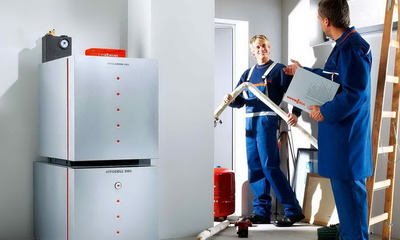
Before you begin work on installing a floor-standing gas boiler, stock up on the necessary tools and materials. To work you will need:
- instruction for equipment operation;
- cement and sand to create a concrete screed;
- wooden edging;
- container for cement mortar;
- shovel for applying cement;
- pipes for flue and chimney;
- drill for making holes;
- bolts, hammer and nails;
- the boiler itself.
After preparing all the necessary tools and materials, you can begin preparing the place for installing the floor-standing gas boiler.
Important! Before installation read the instructions carefully and check whether the declared technical characteristics of the equipment correspond to the data of the device itself.
Preparing the site
Before installing gas equipment Prepare the firebox room carefully and a place directly for installing the boiler. The main requirements for the premises are:
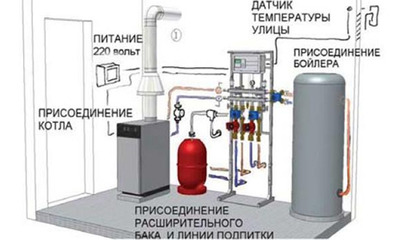
- the area of the firebox is not less than 4 cubic meters;
- walls of the room covered with fireproof materials;
- availability wide doorway and window;
- presence of a chimney.
The room itself must be free. In the room there should be no niches or other cavities, where an explosive gas mixture could accumulate over time.
When installing a boiler in an apartment, it is necessary to place a space under the device lay a fireproof sheet of metal. Asbestos cement sheets are not suitable, since their fire-resistant qualities leave much to be desired, and the SES will not allow the presence of asbestos-containing materials in residential premises.
When installing a boiler in a private house, a special room is also equipped for it. In addition, the boiler is installed in a tray located at least 30 cm below the floor level. The pallet is covered with metal sheets or a concrete screed is made.
Installation of a chimney
Installation of gas equipment is impossible without installation of a chimney. From the presence of a device for removing combustion products the safety of work depends largely the entire heating system.
Modern equipment equipped with automation, which provides control over the draft in the chimney. At the same time, the gas supply is automatically regulated. If there is no necessary draft, the gas supply is immediately stopped.
To the chimney impose mandatory requirements:

- diameter the chimney must match the size, specified in the equipment operating documentation;
- the chimney must extend beyond the roof by at least 50 cm;
- chimney desirable round diameter;
- the optimal material for a chimney is steel.
The chimney assembly is carried out in a vertical position. There should be no gaps or cracks during assembly. After assembly, all parts are carefully attached to the wall.
Connection to the heating system
At the bottom of the boiler there are tubes for connecting hot and cold water supply. The return and hot water supply to the radiators should be connected in strict compliance with all requirements and rules. When piping sealants are used, isolating the system and preventing water leaks when starting the system.
When connecting the heating system to the water supply pipe filter is used, which will help prevent contaminants from getting into the boiler. It is necessary take care of the shut-off valvesThis will help to facilitate repair and dismantling of equipment.
How to connect to a gas pipeline
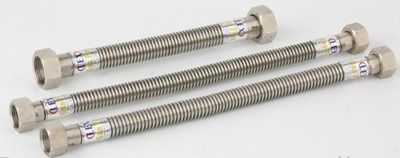
First, the branch pipe is connected to the branch of the gas pipe. It must be equipped with shut-off valve. Gas is supplied to the boiler by means of flexible steel hose.
Pay special attention to sealing all gas pipeline connections. For these purposes, special silicone gaskets, tow and paint are used.
Important! When connecting equipment to a gas pipeline, it is prohibited to use hoses. made of rubber.
Useful video
Watch the video to learn how to install and start up a gas boiler.
Final works
After connecting the equipment to all systems, don't put it into operation right awayHaste can lead to very dire consequences.
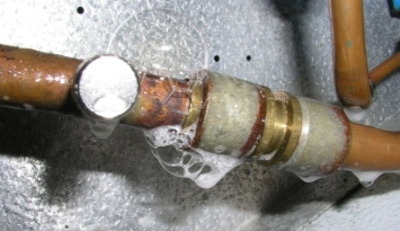
Check again that the connection is correct. water and gas supply systems to the equipment. Water and gas should not leak anywhere. To check the tightness of the gas pipeline wet the joints with soapy water.
At the site of the leak, bubblesIf everything is connected correctly in accordance with the requirements and rules, no problems should arise.
First launch equipment all the same It is better to do it with specialists from Gorgaz, even if you installed the heating equipment yourself.








